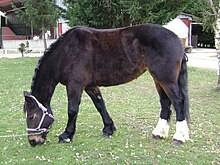
The Selle Français (SF) is a breed of sport horse from France. An athletic horse with good gaits, it is usually bay or chestnut in color. The Selle Français was created in 1958 when several French riding horse breeds were merged into one stud book. The new breed was meant to serve as a unified sport horse during a period when horses were being replaced by mechanization and were transforming into an animal used mainly for sport and leisure.

The Boulonnais, also known as the "White Marble Horse", is a draft horse breed. It is known for its large but elegant appearance and is usually gray, although chestnut and black are also allowed by the French breed registry. Originally there were several sub-types, but they were crossbred until only one is seen today. The breed's origins trace to a period before the Crusades and, during the 17th century, Spanish Barb, Arabian, and Andalusian blood were added to create the modern type.

The Trait Breton is a French breed of draught horse. It originated in Brittany, in north-west France, from cross-breeding of local horses with various other breeds. It is strong and muscular, and often has a chestnut coat.

The Trait du Nord, previously also known as Ardennais du Nord or Ardennais de type Nord, is a breed of heavy draft horse developed and bred in the area of Hainaut in western Belgium and in northeastern France. Originally considered a subtype of the Ardennes, it was recognized as an individual breed with the opening of a studbook in 1903. Developed in the fertile Flemish grasslands, it was bred for size and pulling power for agricultural work. By 1855, the horses bred near Hainaut were considered by some veterinarians to be superior to other Flemish draft breeds. The Trait du Nord was used extensively in mining from the late 19th century through 1920, with lesser use continuing through the 1960s.

The French Saddle Pony, also called the Poney Français de Selle, is a pony breed developed as a sport pony for children and smaller adult riders. It was initially developed in 1969 as the Poney de Croisement, and in 1972 a stud book was created. In 1991 the stud book was closed and the breed renamed to Poney Français de Selle. The breed combines a mix of French and British pony breeds, as well as Thoroughbred and Arabian blood, to create the horse seen today. Due to the large number of breeds used to create the French Saddle Pony, there is not yet a defined set of physical characteristics for the breed, although all tend to be suited for competition in English riding disciplines, including dressage, show jumping and three-day eventing. They fill a similar role as the British Riding Pony and the German riding pony.

The Anglo-Norman horse is a warmblood horse breed developed in Lower Normandy in northern France. A major center of horse breeding, the area had numerous regional types that were bred to one another and then crossed with Thoroughbreds to form the Anglo-Norman. Various body types developed within the Anglo-Norman breed, two of which were split off to form the Norman Cob and French Trotter. The remaining types were eventually standardized, although there remained some criticism of the "hybrid" nature of the breed's conformation. However, it is successful as an international sport horse, especially in the sport of show jumping. The Anglo-Norman also contributed to the development of several other breeds in Europe and Asia.
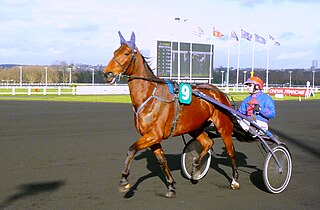
The French Trotter is a French breed of trotting horse bred for racing both ridden and in harness. It was bred specifically for racing in the 19th century (1800s), principally in Normandy in north-western France.

The Charolais or Charollais is an extinct breed of warmblood horse from the Charolais, the country lying around the town of Charolles, now in the Saône-et-Loire département of Burgundy, in eastern central France. Like other French warmbloods, it was the result of crossing local agricultural horses with the Thoroughbred, and was known by the name of the region without ever having a specific stud-book. Like other French warmbloods including the Angevin, the Charentais, the Cheval Limousin and the Vendéen, it was fused with the Anglo-Normand in 1958 in order to create the national warmblood stud-book, the Selle français. It was originally used as a multi-purpose horse for riding, driving, and agriculture. During the late 19th century, additional Thoroughbred blood was added and a new type emerged that was principally used as a light cavalry mount. It was also used for dressage and show jumping.

The Charentais and Vendéen are extinct breeds of horse from western France. They were bred principally in the area around Poitou-Charentes and Vendée, France. They were used as a mount for light cavalry.

The Belgian Sport Horse, Dutch: Belgisch Sportpaard, French: Cheval de Sport Belge, is a Belgian breed of warmblood sport horse. It is one of three Belgian warmblood breeds or stud-books, the others being the Belgian Warmblood and the Zangersheide. It is bred for dressage, for show-jumping and for three-day eventing.
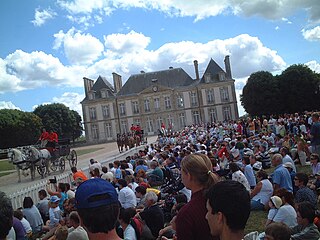
Horses in Normandy have a clear economic importance, particularly through breeding. Present since the Bronze Age, horse breeding developed with the establishment of the Haras du Pin stud farm. Horses are still a very much alive tradition in this region. Normandy boasts a number of renowned racecourses, in particular the one in Deauville, where events take place regularly, including international ones such as the 2014 World Equestrian Games.

The Norfolk Phœnomenon is a black-coated stallion of the Norfolk Trotter breed. He is a son or grandson of the most famous English trotter stallion of his time, The Norfolk Phenomenon. He was imported to France in 1851 on a mission from the Haras Nationaux.

Conquérant was a founding stallion of the French Trotter horse breed, born in 1858 in Cotentin, Normandy, to breeder Pierre Étienne Joseph-Lafosse, and died in 1880. Son of the mare Élisa and the stallion Kapirat, descended through him from the almost Thoroughbred Young Rattler, he had an excellent racing career in mounted trotting for the Basly stable. Sold to the Haras Nationaux in 1862 after his racing career, Conquérant became a sought-after sire of 66 trotters.

Corlay (1872-1897) was a stallion close to the Thoroughbred, head of the Corlay horse breed, considered in his day to be one of Brittany's most famous and influential stallions. The history of this sturdy roan horse is steeped in legend. It is generally accepted that he was the son of Flying Cloud, a Norkfolk Trotter stallion imported from England to Brittany in 1864, and a local three-quarter Thoroughbred mare, Thérésine.
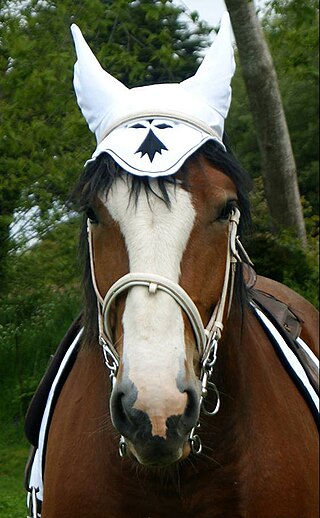
Horses in Brittany have a clear historical, economic and cultural importance, since their introduction often attributed to the Celts. In Brittany, the horse, generally a Breton bidet, was mainly used as a saddle animal until the middle of the 19th century. As roads improved, most breeders specialized in draft horses and carriage horses. They mainly settled in the west, in Basse-Bretagne, Trégor and Léon. The Breton draft horse, a renowned working animal, was exported in large numbers from Landivisiau in the early 20th century.
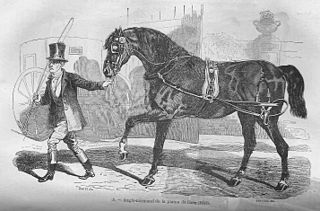
The Carrossier noir du Cotentin is a large, black, pulling horse breed unique to Cotentin. It was regularly described and quoted during the Ancien Régime and may have descended from Danish horses. As its name suggests, this horse was mainly used to pull carriages, and its uniform color made it possible to form homogeneous groups.

The Merlerault is a formerly common breed of horse that originated in the canton of Le Merlerault. Bred under the Old Regime, this reputedly elegant half-bred was used to ride and pull tilburys.

A meat horse, or slaughter horse, is a horse bred for its ability to yield meat. Coming from draft horses formerly used for agricultural work, these horses are threatened with extinction by the mechanization of agricultural activities. This state of affairs has prompted breeders to look for new economic outlets. Breeding for meat horses was very popular in France in the 1980s, helping to safeguard these breeds. It has developed in Italy and Spain, but is declining in France, due to the further reduction of work activities with draft horses.


